



This page will take a moment to load on dial-up - please be patient - thank you.
 |
| Describing the Design by Gerard Pas In contemplating my design, I knew that I had to keep the center of focus directed to the Cenotaph. I wanted to create something that could adorn it as a fine string of pearls adorns the beauty of a woman. All of my years of emotions and history with this object described above, also influenced how I would respectfully compliment this symbol of courage, liberty and sadly loss. My generous Dutch benefactors wanted to place music there, next to the Veterans Garden, serenading the Cenotaph and its honourable symbol. When
designing the ground works or sculptures, I did not want to create a signature
of death as one might be influenced by a grave stone. I wanted to show
the same respect to the fallen dead as such a grave stone demands but
to add meaning for us the living. As I had studied war, I knew the significance
of the letter V as it originated from the hand of Winston Churchill to
become the symbol of Victory. I did not want to simply portray Victory
alone but I wanted to add meaning to the symbol of this V. Firstly the
sculptures are comprised of two sections, the first a large black granite
V and the second a dedication stone. With a vision to keep the V clearly
in the forefront, I dissected the V ever so slightly by placing the dedication
stone protruding from its side. The result was to create a subtle hint
to letter N; being the first letter of the Netherlands. Those who fought, those who died and those that continue the struggle today in the far reaches of this world, can hear this proclamation as they ring out from the Dutch Carillon which accompanies these solemn stones. Not only will this memorial speak out, that from the brokenness of War, Victory can come but that Liberty can exact a high price, as it did for our liberation in Holland. These stones will oscillate to the songs of thanks playing in the canopy of steel above them. When
first designing the Carillon I wanted the whole project to keep within
the tectonic forms of architecture in the cube / parallelopied, sphere
/ circle, conical / triangle. The sculptures lying at its feet take the
form of the triangle with the dedication stone being the rectangle. The
carillon is the circle. My initial design was a spiral on which 12 bells
would be mounted. Necessity forced this original conical spiral to be
changed to three rings or circles holding the now 18 bells. The additional
bells where added to not only aesthetically balance the rings but to compliment
a full octave and one half of notes, making almost all songs playable
on it. These three rings can be considered like ripples in the water and
I hope to suggest that every soldier that gave his life in Holland, had
such an effect to leave ripples in history. Made of stainless steel this
tower will hold up these three ascending rings as a prayer reaching up
the heavens. In designing the sites grounds, I wanted to create a garden that took into consideration the purpose for this monument, as well as complimenting the sculpture and carillon. For we Dutch, May 5th is Liberation Day in the Netherlands and thus I wanted the site to be in full colour for this event in spring. I used plants that would bloom Orange on top of a field of muted violet for this May day. On November 11th, I also wanted the site to look green and colourful on this somber fall day so evergreen shrubs and plants were used. Throughtout the summer orange day lilies will colour the gardens. It is my hope that this sculpture and Carillon will invoke the knowledge of our gratitude, as Dutch, to the Canadian War Veteran. Resounding a beautiful litany of song throughout the years, reminding those who come after us of that we will never forget the cost of our Liberty. Oh Canada our home and native land, will chime from the Carillon's rafters embracing the air throughout the seasons and it plays Bach and the Beatle to. Gerard Pas - London Canada 2006 |
... please click on any of the images below for an enlargement ...
"Canadian
Veterans Memorial" "Liberation Sculpture and Memorial Carillon" by Gerard Pas © 2006 8 metre tall carillon (bell tower) — with 60cm. tall by 3 by 3 metre wide sculpture stainless steel carillon with bronze bells — granite ground sculpture Installed in Victoria Park, London, Canada next to the Cenotaph - September 22, 2006. |
|
| Detail
from Gerard's above rendering. The completed carillon (bell tower)
and dedication sculpture in situ at the Victoria Park site in winter. * I used Photoshop to create these rendered drawings. G.P. |
Rendering
by Bob Darnell of Excellent Signs and Displays
illustrating the complete installation of Gerard's “Memorial”
design. * Bob's rendering shows too many leaves ascending / descending the pole G.P. |
A
scale model by Piet Teunissen |
Scale
model of the Liberation Sculpture This two coloured granite sculpture will lay at the base of the Memorial Carillon. |
Scale
model of the Canadian Veterans Memorial made by Piet Teunissen. |
||
Piet
Teunissen and Rinette Teunissen are members
of the Veterans Memorial Committee, whose idea it was to create and
gift this work to the veterans of London Canada. Piet in fact, came
up with the original idea and concept before I was asked to design
the memorial. In many ways this whole project is the making and hard
work of Piet Teunissen who joined with Jan Maarschalkerweerd to start
this project some years ago. Piet Teunissen taught for many years in the Engineering Dept. of the University of Western Ontario U.W.O., where he worked in Boundary Layer Wind Tunnel Laboratory. Piet has created many models of world renowned buildings and structures that where tested in this wind tunnel at U.W.O. Piet created this wonderful scale model of Gerard's design. It was then used in the presentations to the various committees of the Municipality of the City London, in order to gain permissions to locate this memorial in Victoria Park adjacent to the Cenotaph. This was all done with the full support of the Royal Canadian Legion in London who attended the numerous City Hall meetings together with the Veterans Memorial Committee. |
||
*
I can't begin to express my sense of respect to the Legion members
from London. Not only for their gift so many years ago, for which
this memorial is dedicated, but for sitting there next to me at City
Hall in the many meetings we had to get this project passed by the
city of London. I was really supported by them in my design and they've
stood behind this project since Piet Teunissen first suggested it.
Thank you. G.P. * I would also like to comment on what a great pleasure it is to have such a master craftsman like Piet Teunissen build a model of this design. As a model maker myself I know what tedious work goes into realizing a full scale model. Piet's accuracy in building this model extended to turning each bell individually on a lathe. G.P. |
||
|
|
||
| CAD rendering of the Carillon's profile. | CAD
rendering of a worms eyes view of the Carillon. |
|
| These
two Computer Assisted Design CAD renderings where made by Abuma Manufacturing
of London, Canada. The Carillon will be made of stainless steel and
manufactured by Abuma at their London Canada plant. The tower will
be 8 metres tall with three rings descending in size as they go down
the pole. Each ring will be held with two supports. On each ring will
be 6 musical bronze bells, with a total of 18 bells also descending
in size on each ring. Additionally, ascending / descending the pole
will be a spiral wreath of stainless steel maple leaves running up
the towers centre pole. |
||
Jan
Maarschalkerweerd is the President of Abuma Manufacturing
in London. He began this company after establishing and leaving Trojan
Technologies Inc. also of London. Together with Piet Teunissen this
project started off as their cooperative idea. |
||
*
Jan brings his erudite understanding of manufacturing to this project,
both as an engineer and as someone who actually makes real structures
with in the manufacturing environment. Through his learned assistance
we where able to apply the laws of engineering to my original design
and compromise it to its completed form, as seen above. If as the
artist, I am the heart behind this design then Jan is the head. What
a privilege it is to work with such an adept individual as Jan. G.P. |
||
|
|
||
Structural
drawing of the Liberation Sculpture with dimensions by Piet Teunissen. |
This
structural drawing shows the final measurements of the completed Liberation
Sculpture. The sculpture consists of two granite components. The first
is a large black V with the word VICTORY inscribed in its top. The
second is a dedication stone made of a gray granite with the memorials
dedication text inscribed in its top. This second component will be
hollowed and contain the PLC computer which controls the bells of
the carillon. |
|
|
| Memorial Landscaping and Grounds | |
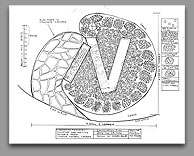 |
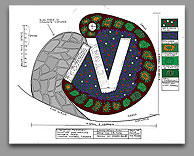 |
Gerard's
landscape design for the Canadian Veterans Memorial site. |
|
When
planning a public sculpture many factors come into play because it
must be scrutinized for cost of production, strength, endurance, safety,
liability, maintenance, nuisance factors like vandalism, etc. Before
presenting such a project to City Hall, all these plans must be in
place, so that the various committees of City Council can determine
the projects feasibility, aesthetic appeal, and cost to the taxpayer.
Once all these criteria have been met and no citizen objects, permission
is given to use the Cities land and place the public sculpture (Memorial)
into place. Gerard created these landscape plans to surround his Memorial design. * My father Martin Pas has been a gardener / landscaper all of my life in Canada. Growing up, I was always surrounded by flowers, greenhouses, nurseries, and the hard work of landscaping. I wanted to apply all that I have learned in my 50 years of gardening to this site in my landscape plan. G.P. |
|
While
working on this project I have had a lot of contact with the City
of London's Planning and Development Department. This dept., namely
Andrew Macpherson and Julie Michaud have been extremely supportive
and helpful throughout the entire process of bringing this public
work from it’s infancy to a reality. Julie Michaud a Landscape
Architect with the City's Planning dept. came up with an enhancement
to my original landscape design. Essentially, she made very little
changes to the original design except to enlarge the surrounding gardens.
She did this by first mirroring my design to create a circle and then
add new spaces, including new plants. Additionally, she replaced my
shrubs with the more formal Boxwood shrub. These few changes make
such aesthetic sense that I am very happy to show you her concept
drawing of what I hope the gardens will now look like surrounding
the Veterans Memorial. |
|
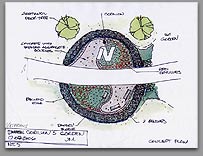 |
|
| Julie
Michaud, Landscape Architect City of London, Planning and Development Department. Enhanced concept drawing for the gardens surrounding the Canadian Veterans Memorial site. |
|
|
|
|
| Piet
Teunissen and Veterans original design as rendered by Bob Darnell. - this was the design before the Veterans Memorial Committee asked for Gerard's involvement - |
|
|
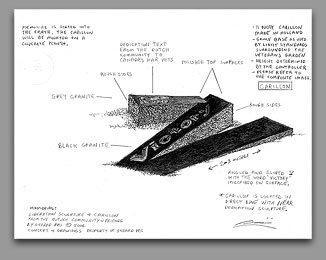 |
|
| Gerard initially brought this new design for the sculpture. | |
I
became involved with this project when Wyn Geleynse and I were asked,
by Sir Richard Ter Vrugt the Netherlands Consul of
Southwestern Ontario, to consult with the Veterans Memorial Committee
on a design they wished to bring forth to the City of London for approval.
Sadly, we had to inform them that their current design required substantial
development and that it would probably not receive permissions by
the City's recently formed Public Art Committee to go into Victoria
Park as it was. Sir Richard Ter Vrugt then asked me if I would redesign the sculptural component of the Memorial. I did and presented it to a sub-committee of The Veterans Memorial Committee. After seeing my design (above), they asked if I would continue and also provide a design for the Carillon, which I did and can be seen below. G.P. |
|
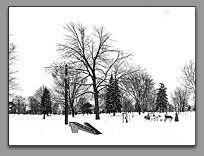 |
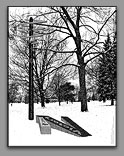 |
Gerard's
complete design as first submitted. After designing the sculpture Gerard was also asked to design the Carillon as seen above. |
|
This
is Gerard's original design for the Memorial - it had a segmented
spiral ascending the tower instead of the current three rings. As in all things in life, large public sculpture requires a degree of compromise, particularly if someone else is paying for the fabrication, then cost factor becomes a concern. In order to keep within budget, Gerard was asked to compromise his initial design, that had the mast of the carillon as a large ascending steel spiral with segments of the spiral cut out. In order to realize this, we would have been faced with a large fabricating concern in bending 50 metres of stainless steel into small sections and then welding them back together into a spiral. We were concerned that in welding the spiral together from these smaller segments, we might develop flat spots in the form. It was thus elected, after consultation with Jan Maarschalkerweerd that we would use three ascending rings in the spirals place based on his recommendations. * I would have preferred to keep the original design and the ascending spiral, as I think my first design is more poetic. G.P. |
|
|
|
|
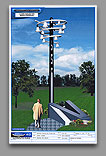 |
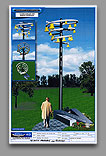 |
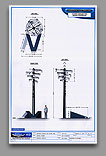 |
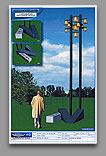 |
A |
B |
C |
D |
All
four of the above renderings were created by Bob Darnell of Excellent
Signs and Displays. The above images provide a chronology of Gerard's design before it reached its final stage, as seen at the beginning of this page. A & B illustrate two colour schemes for the Carillon that Gerard designed. C provides dimensions. D shows Gerard's first design for the sculptural component of the Memorial with the previous Carillon design. * I don't think that above renderings ever truly captured my idea for the sculptural component, as can be seen in my drawing above. This has since been remedied. G.P. |
|||
|
|
|||
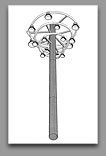 |
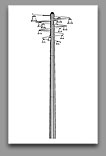 |
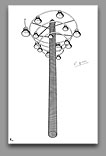 |
worms
eye view of spiral with a 10.16 diameter stainless steel pipe |
profile
view of spiral with a 5.08 diameter stainless steel pipe |
worms
eye view of spiral with a 5.08 diameter stainless steel pipe |
The
three CAD renderings above were provided by Abuma Manufacturing. They
show Gerard's Carillon design in its original spiral form. The
spirals in the above renderings have not been segmented as in Gerard's
original design above. |
||
| Site pre-memorial |
| Victoria Park - London - Canada |
| Adjacent to the Veterans' Garden and Cenotaph |
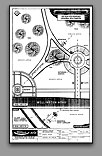 |
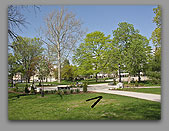 |
Overhead
map of the site. |
V
marks location where this memorial will be located. |
Panoramic photo of the site in Victoria Park. V marks location of memorial. |
|
The
memorial was positioned so that the large granite V was in a direct
axis or pointing to the Cenotaph. The memorial is located at the corner of Dufferin and Wellington Streets near The Veterans' Garden (to the far left with benches). The Cenotaph is central in the distance (because of lens) please refer to the above map. The Memorial will be across from London City Hall and London Life Insurance Company. |
|
|
|
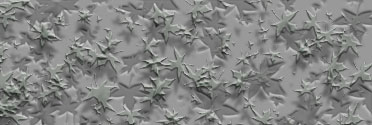 |
Thoughts on Victoria Park that inspired Gerard Pas
As a young man and now today, I have known London, Canada's Victoria
Park Cenotaph almost all of my life. When
asked by the Dutch community to create and design a carillon with
sculpture, to be given as a gift to all Veterans of the Canadian Armed
Forces, The Royal Canadian Legion - London, and the City of London,
I went back to the Cenotaph again. Gerard Pas - London Canada 2006 |
| return to Memorial Index |
| return to top of page |